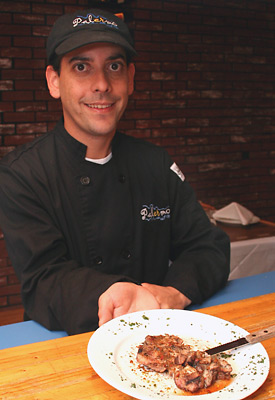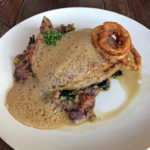 |
| There’s nothing sweet about sweetbreads – Palermo Viejo chef Francisco “Frank” Elbl shows off the Argentina delicacy, which consists of … wait for it … a calf’s thymus gland. LEO Photo by Nicole Pullen. |
LEO’s Eat ‘n’ Blog with Louisville HotBytes
(“Challenging” dishes at Palermo Viejo, Tokyo Japanese, India Palace)
It’s Halloween, blustery winds are whistling through the eaves and rattling the leaves, and there are ghosties and ghoulies and things going bump out there in the night. Let’s eat something scary!
How about a nice plate of sweetbreads, my dearies? The name sounds so appealing. Sweet meets bread. A dessert of some sort? A comforting sweet roll? Well, no. “Sweetbread” is a culinary euphemism, actually, for an organ that would be a much harder sell if it were explicitly identified as a calf’s thymus gland. It’s innards, OK? And it’s delicious.
Today let’s celebrate Halloween with visits to three local favorites for a trio of “challenging” dishes that tickle the taste buds but may require the diner to willingly suspend disbelief long enough to get them down. Trick or treat!
The sweetbreads at Palermo Viejo
Louisville’s only Argentine restaurant has been a favorite since it opened in 2001. Its exposed brick, leather-look table coverings and open kitchen with super-hot Argentine-style parilla grill come together in happy combination with an authentic Argentine menu.
You can order the sweetbreads a la carte, although it’s not listed on the menu. My favorite option here, though, is La Parilla (“The Grill,” $16 per person), which brings out three-quarters of a pound of mixed grilled meats on an individual black-metal parilla: a chunk of rare flank steak, a strip of thin-sliced, flanken style short beef rib, a deeply earthy length of house-made Spanish chorizo sausage, and, of course, a bite of sweetbreads.
The sweetbread is a squarish piece of meat about the size of a rough-textured iPod Nano. Take a nervous taste, and if you can manage not to think too deeply about internal organs, you’ll be rewarded with a taste surprise as your teeth burst through the golden-brown, crisply seared surface to reach a rich interior with a deeply intense veal flavor and a texture that’s somewhere just to the solid side of heavy cream. Three or four bites and it’s gone, and you will wish you had more.
We didn’t go for a second order – this time – but bolstered a hearty Argentine meal with excellent hearts-of-palm salads; the trademark provoleta appetizer ($6), a pool of molten aged Provolone cheese topped with a ration of dried herbs, sort of an Argentine pizza without crust or tomatoes; and a Spanish tortilla, not your Mexican flatbread but thick wedges of frittata-style omelet loaded with tender chunks of potato.
All this plus a bottle of deliciously earthy Los Altos Malbec ($17) from Palermo’s all-Argentine, ridiculously affordable wine list, and an outstanding dinner for two came to just $50.86 plus $11.14 tip.
Palermo Viejo
1359 Bardstown Road
456-6461
The ankimo (monkfish liver) at Tokyo Japanese
It may not be politically correct to enjoy foie gras these days, as animal-rights activists raise concerns about the force-feeding process used to fatten the geese that provide the livers used in this rich and calorie-laden treat. (I’m not fully convinced, having seen French geese come happily honking to the source at feeding time, and being painfully aware that anyone who’s not a vegetarian needs to know that animals have to be slaughtered to put meat on our plates.)
If you’d like to go a step beyond foie gras and don’t mind another culinary challenge, let me introduce you to monkfish liver, which both French and Japanese cultures recognize as “the foie gras of the sea.”
Monkfish, known as lotte in France, is a flat-faced, big-mouthed ocean-going bottom dweller that may be the world’s ugliest fish, and it comes with a liver to match. Said organ – called “ankimo” in Japan – is a bulbous lobe that often reaches a foot in length and weighs in at a pound or more. Pale tan in color and silken in texture, it bears a surprising resemblance to goose foie gras, and any self-respecting sushi chef would consider it a sin to cook it.
Ankimo is rare in the United States, but it turns up occasionally at sushi bars, and we were intrigued to find it as a special recently at Tokyo Japanese, a small, unimposing but excellent family-run sushi spot near Holiday Manor.
It was prepared in classic Japanese fashion: Utterly fresh fish liver was neatly cut into small, soft dice that weren’t fishy at all but custard-smooth and sweet, tossed with a tart, unsweet citrus ponzu sauce and a fine-chopped vegetable garnish with a distinct dash of fiery spice. It was a truly exotic combination, not for the faint of heart, but once we got past the first taste, I matched my wife bite for bite until the small portion was gone.
As long as we were there, we bellied up to the bar and enjoyed way too much sushi from the friendly chefs: luscious, tender toro, the fattiest of tuna, a rosy pink marbled with white like a prime rib eye; white tuna, pale as snow; fresh Spanish mackerel, subtle and intense, topped with a tiny, celebratory dab of caviar. Tempura shrimp crunch roll with “crab” and cucumber drizzled with sweet, thick eel sauce. Regular tuna roll and a vegetarian palate cleanser, avocado roll and well-made, fresh sushi bites of maguro (regular tuna), hamachi (yellowtail) and tai (red snapper). A cup of miso soup, a salad of crisp, cold iceberg lettuce and tangy-sweet pale orange ginger dressing; hot green tea and a big bottle of Kirin Ichiban lager … who could ask for more?
Sushi’s not cheap. We ate a lot, racked up a $73.49 tab plus a $15 tip for the servers and 10 bucks in the fish bowl for the guys behind the bar, and it was worth it. We waddled out happy into the suburban sunset, thinking of monkfish liver.
Tokyo Japanese Restaurant
2415C Lime Kiln Lane
339-7171
www.tokyosushis.com
The goat curry at India Palace
The average American consumes 212 pounds of meat per year, and just 2 ounces of this protein-rich repast comprises goat meat. Goat is a growth industry with a growing crowd of immigrants coming from Mexico, the Caribbean, the Middle East and parts of India where the humble goat is prized; but we Anglos clearly aren’t eating our share.
Frankly, Westerners haven’t been quick to embrace the goat. We think goats eat garbage and we’re pretty sure they’re stinky. Despite the tasty evidence to the contrary presented by such local favorites as Southern Indiana’s Capriole Farms – a lot of people aren’t even ready for goat cheese, much less goat meat.
If you’re ready to get your goat, though, you’ll find it at a variety of ethnic eateries. Check out the more authentic taquerias (where it may be listed as “cabrito”) or Middle Eastern establishments; you’ll usually find goat, too, at Taste of Jamaica in Clifton.
Perhaps the easiest introduction comes in the spicy goat curry that’s usually offered on the lunch buffets at the East End Indian eateries Shalimar and India Palace. If you’re uneasy about chowing down on goat, buffet service makes it easy to try just a taste while you fill up on more familiar fare.
Goat curry is cooked with bones in, as a helpful sign on the India Palace buffet pointed out. If you’ll fish around in the thick, spicy dark-brown sauce, though, you’ll find plenty of bite-size chunks of meat. It’s not really all that exotic: This curried rendition had the soft, almost gelatinous texture of long-simmered stewing beef, with a strong but not unpleasantly earthy flavor reminiscent of mutton. If you like lamb, you won’t hate goat.
India Palace
9424 Shelbyville Road
394-0490
www.indiapalaceky.com



